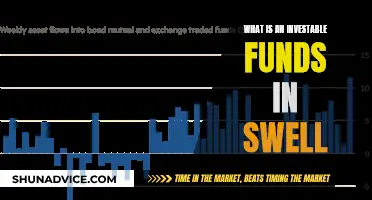
Investing in mutual funds can be a great way to grow your wealth over time. For those who have invested wisely, mutual funds have generated substantial returns over the past two decades, with some of the best funds returning over 20% per annum for as long as 20 years. However, it is important to invest wisely, and there are several things to keep in mind when investing in mutual funds. This includes regular investment, staying invested for the long term, and routine re-evaluation. In this article, we will discuss some tips and strategies for investing wisely in mutual funds to maximize your returns and minimize your risks.
| Characteristics | Values |
|---|---|
| Regular investment | Systematic Investment Plans (SIPs) |
| Long-term investment | Compounding |
| Rebalancing | Routine re-evaluation |
| Investment options | Real estate, starting a business, the stock market or art |
| Stock market investing | Individual company stocks, stock funds |
| Individual stock investing | Owning a piece of companies |
| Index funds | "Baskets" of hundreds or thousands of different investments |
| Bonds | Loans to companies or governments |
| Real estate investing | Apartments or commercial buildings that are leased |
What You'll Learn
- Regular investment: Systematic Investment Plans (SIPs) are a good method to take advantage of cost averaging
- Long-term investing: Mutual funds generally provide the best returns when invested for long durations
- Rebalancing: Check a mutual fund's ratings and switch if its rating has gone down
- Factor index funds: A smart combination can help outperform plain-vanilla indices
- Harvest capital gains: Regular churning will keep gains from equity funds below the threshold

Regular investment: Systematic Investment Plans (SIPs) are a good method to take advantage of cost averaging
Regular investment in mutual funds through Systematic Investment Plans (SIPs) is a good method to take advantage of cost averaging. SIPs allow investors to make regular, equal payments into a mutual fund, trading account, or retirement account. This helps investors save regularly with a smaller amount of money while benefiting from the long-term advantages of dollar-cost averaging (DCA).
Dollar-cost averaging involves buying a fixed-dollar amount of a security, regardless of its price, at each periodic interval. This means that shares are bought at various prices and in varying amounts. As a result, an investor ends up buying fewer shares when unit prices rise and more shares when prices drop. This reduces the average cost per share of the security over time.
SIPs are passive investments, meaning that once you put money in, you continue to invest in them regardless of their performance. This is why it's important to monitor your SIPs and, once you've hit a certain amount or are nearing retirement, consider moving to an actively managed strategy to grow your money further.
SIPs are a good option for investors who don't have superior financial knowledge or the time to analyse market movements and the right time to invest. With SIPs, you can sit back and relax as the money is auto-deducted from your account and invested in mutual funds. The automation also ensures that your investment grows, as opposed to a lump-sum investment, where you may forget to invest at times.
The rupee-cost averaging factor of SIPs allows investors to take advantage of market volatility. Since the investment amount is constant, the fixed amount averages out the value of each unit. This means that you can buy more units when the market is low and fewer units when the markets are high, lowering the average cost per unit.
SIPs are a popular investment tool, with nearly $3 billion of gross flows entering mutual funds through SIPs. They are particularly popular in India, with the number of SIP accounts crossing 9.874 crore as of September 2024.
Parag Parikh Flexi Cap Fund: Smart Investing Strategies
You may want to see also

Long-term investing: Mutual funds generally provide the best returns when invested for long durations
When it comes to investing in mutual funds, a long-term approach is often the wisest strategy. This means investing for several years or even decades, with the understanding that the value of your investment may fluctuate in the short term. Here are some key things to keep in mind:
Compounding returns
One of the biggest advantages of long-term investing in mutual funds is the power of compounding. Compounding occurs when the returns on your initial investment are reinvested, leading to exponential growth over time. The longer you stay invested, the more your returns can compound and grow. This is a significant factor in building wealth over the long term.
Reduced risk
Long-term investing in mutual funds can also help to reduce risk. While short-term investments are often susceptible to market volatility and interest rate changes, long-term investments have a better chance of riding out these fluctuations. By holding onto your investments through various market cycles, you increase the likelihood of benefiting from overall market growth.
Lower transaction costs
Long-term mutual funds typically have lower turnover ratios, resulting in fewer buying and selling activities. This leads to lower transaction costs compared to short-term funds, which can result in significant cost savings for investors.
Tax advantages
In many cases, holding mutual fund investments for the long term can result in favourable tax treatment. For example, in some jurisdictions, investments held for more than a year may qualify for lower capital gains taxes. This can further enhance the overall returns on your investment.
Patient investing
It's important to remember that long-term investing requires patience and discipline. There may be times when your investments underperform or experience losses. However, making impulsive decisions based on short-term market movements can often be detrimental. Instead, focus on the long-term performance of your mutual funds and stick to your investment strategy.
Regular investment
To make the most of long-term investing in mutual funds, consider making regular contributions through a Systematic Investment Plan (SIP). This involves investing a fixed amount at regular intervals, such as monthly or quarterly. By investing consistently, you can take advantage of cost averaging and avoid the challenge of timing the market.
In summary, long-term investing in mutual funds can provide significant benefits, including compounding returns, reduced risk, lower costs, and potential tax advantages. However, it requires a patient and disciplined approach, with a focus on long-term performance rather than short-term market fluctuations.
Understanding Passive Index Funds and Their Investment Types
You may want to see also

Rebalancing: Check a mutual fund's ratings and switch if its rating has gone down
Rebalancing is a crucial step in maintaining a healthy portfolio of mutual funds. It is the process of restoring your portfolio to its original asset allocation by buying and/or selling shares to bring the allocation percentages back into balance. This is an important step, even for buy-and-hold investors, as it helps to minimise risk and ensure your portfolio isn't dependent on the performance of a single investment or fund type.
To effectively rebalance your portfolio, you should:
- Establish an asset allocation plan: Consider your income, expected retirement time, risk tolerance, and investment objectives.
- Assess your current asset allocation: Identify where your current investments are placed, such as in stocks, cash, or bonds.
- Compare and adjust: Compare your current asset allocation to your target allocation and make adjustments as necessary.
- Be mindful of tax implications: Consider the costs of brokerage, Securities Transaction Tax (STT), and potential exit load charges when selling investments within a specific period.
- Review and rebalance: Review your portfolio regularly, but only rebalance when the allocations are significantly off-target. Once a year is typically sufficient for rebalancing.
When rebalancing, you will sell shares of the funds that have performed well and buy shares of the underperforming funds. This strategy may seem counterintuitive, but it helps maintain the desired asset mix and ensures your portfolio isn't overly exposed to risk.
Additionally, checking the ratings of your mutual funds is a convenient way to assess their quality. If a fund's rating has decreased, it may be time to switch to a better-performing fund within the same category. This step ensures that you stay invested in funds that are meeting performance expectations.
Small-Cap Funds: Smart Investment, Big Returns
You may want to see also

Factor index funds: A smart combination can help outperform plain-vanilla indices
Factor index funds are making a mark in index investing. These funds can outperform generic index portfolios. However, not every factor fund is relevant, and one needs to go with data and analysis.
Factor funds are funds that invest based on a given set of criteria expected to impact portfolio performance. Some of the factors that influence stock allocation are quality, momentum, low volatility, and value. They focus on identifying stocks from within the index that best exhibit the chosen criteria and invest in them.
For example, the iShares MSCI USA Size Factor ETF focuses on US large- and mid-capitalization stocks with relatively smaller market capitalization, with the idea that smaller firms tend to be overlooked. The iShares MSCI USA Momentum Factor ETF invests in stocks with accelerating price and volume, while the iShares MSCI USA Value Factor ETF weights securities according to four accounting variables and compares these to the parent index.
Factor ETFs can help investors increase their returns, improve investment performance, and manage risk. They deviate to some degree from simply moving up and down with the specified market.
Smart beta strategies target factors using a rules-based approach, usually with the goal of outperforming a market-cap-weighted benchmark. They are now widely available in ETFs and mutual funds, making factor strategies affordable and accessible to every investor.
Enhanced strategies use factors in more advanced ways, trading across multiple asset classes and sometimes investing both long and short. Investors use these enhanced factor strategies to seek absolute returns or to complement hedge fund and traditional active strategies.
A Step-by-Step Guide to Index Fund Investing
You may want to see also

Harvest capital gains: Regular churning will keep gains from equity funds below the threshold
Harvesting capital gains is a legal strategy that can be used to reduce an investor's tax liability. This strategy involves selling investments that have decreased in value to offset the capital gains from the sale of profitable investments. By balancing the gains with losses, the overall taxable capital gains can be significantly reduced.
For example, if an investor has made a capital gain of $10,000 from the sale of a successful investment but also has an investment that has lost $4,000, selling the underperforming asset can offset the gain. This would reduce the net taxable gain to $6,000, thereby lowering the capital gains tax owed.
In the context of mutual funds, regular churning, or buying and selling, of equity funds can help keep long-term returns below the tax threshold. For instance, in India, long-term capital gains (LTCG) on equity-oriented mutual funds up to Rs. 1.25 lakh are exempt from tax, while gains above this threshold are taxed at 12.5%. By managing investments and timing redemptions effectively, investors can minimize or even avoid LTCG tax on their mutual fund investments.
It is important to note that tax-loss harvesting only defers tax payments; it does not eliminate them. Additionally, it is crucial to adhere to the wash-sale rule, which prohibits repurchasing the same or a substantially similar investment within a specified period, usually 30 to 60 days, to avoid disqualifying the offset of capital gains.
While tax-loss harvesting can be a useful strategy, it may not be suitable for all investors or situations. It is always recommended to consult a financial or tax professional for personalized advice.
A Beginner's Guide: Investing in Vanguard Growth and Income Fund
You may want to see also
Frequently asked questions
Systematic Investment Plans (SIPs) are a good way to invest in mutual funds. SIPs allow you to invest a chosen amount at regular intervals into a mutual fund of your choice.
As long as you can pay all your expenses and have some money left over at the end of the month, you're ready to start investing. However, it's important to ensure that you are comfortable with your budget, are free of high-interest debt, and have an emergency fund saved up before you begin.
Mutual funds can be a handy way to grow your wealth. They have generated immense wealth over the past two decades, with some of the best mutual funds returning over 20% per annum for as long as 20 years.
You can refer to online ratings to check a mutual fund's quality. If you have invested in a fund whose rating has decreased, it might be time to switch.
It is important to invest regularly, stay invested for the long term, and routinely re-evaluate your investments.







